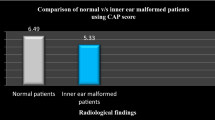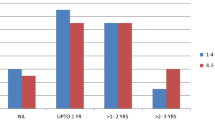Abstract
Retrospective study of the prelingual cochlear implantation programme under government scheme done at medical college hospital in central India. Forty-two prelingually deaf children screened and sent for cochlear implantation at our centre From March 2015 to Feb 2018 were reviewed with respect to their age, sex, preimplantation hearing aid use, surgical technique for cochlear implantation, type of FDA (USA) approved cochlear implant, post operative speech therapy and its outcome with respect to categories of auditory perception and speech intelligibility scoring were compared for children younger than 4 years and older than 4 years. For outcome measurement non parametric statistical method was used for any significance between the two groups. There was a wide range of children implanted ranging from 2 to 7 years. Both varia and mastoidectomy and posterior tympanotomy method of cochlear implantations were done with good rate complete insertion and electrode activation. There was no significant difference between the two group with regard to CAP and SIR outcomes after 1 year. In order to get better outcomes with respect to the speech language development, there is need to strengthen the early identification and cochlear implantation before 4 years of age in government approved schemes.


Similar content being viewed by others
References
Clark GM (2015) The multi-channel cochlear implant: multi-disciplinary development of electrical stimulation of the cochlea and the resulting clinical benefit. Hear Res 322:4–13. https://doi.org/10.1016/j.heares.2014.08.002
Sharma A, Campbell J (2011) A sensitive period for cochlear implantation in deaf children. J Maternal Fetal Neonatal Med 24(01):151–153
Huttenlocher PR, Dhabolkar AS (1997) Regional differences in synaptogenesis in human cerebral cortex. J Comp Neurol 387:167–178
Sharma A, Nash AA, Dorman M (2009) Cortical development, plasticity and re- organisation in children with cochlear implant. J Commun Disord 42(4):272–279
Gilmour L (2010) The inter rater reliability of categories of auditory performance- II. University of Southampton, Southampton
Nicholas JG, Geers AE (2007) Will they catch up? The role of age at cochlear implantation in the spoken language development of children with severe profound hearing loss. J Speech Lang Hear Res 50(4):1048–1062
Vassolare TMF, da Fountoura G, Bergonse R et al (2008) Cochlear implant and large vestibular aqueduct syndrome in children. Br J Otorhinolaryngol 74(2):260–264
Mikhail S, Mandour MF et al (2018) Lateral rotation of basal turn of cochlea with its impact on cochlear implant feasibility. Med J Cairo Univ 86(1):383–387
El-Anwar MW, El Assar AS, Foad YA (2016) Non-mastoidectomy cochlear implant: a literature review. Int Arch Otorhinolaryngol 20:180–184
Tykocinkski M, Cohen LT et al (2005) Measurement and analysis of access resistance and polarisation impedance in cochlear implant recipients. Otol Neurootol 26(5):948–956
Charles TM, Choi, Yi-Hsuan L (2012) A review of stimulating strategies for cochlear implants. Cochlear implants research updates. In: Dr. Cila Umat (Ed), ISBN: 978-953-51-0582-4 InTech. http://www.intechopen.com/books/cochlear-implant-research-updates/stimulating-strategies-for-cochlearimplants
Gonzalez RIB, Castillo SC, Lee GR (2017) Fitting parameters for cochlear implant. Bol Med Hosp Infant Mex 74(1):65–69
Raghunandan S, Ravikumar A, Kameshwaran M et al (2015) Electrophysiological correlates of behavioural comfort levels in cochlear implantees: a prospective study. Indian J Otolaryngol Head Neck Surg 67(3):210–222
Archbold S, Lutmann ME, Marshall DH (1995) Categories of auditory performance. Ann Otol Rhinol Laryngol Suppl 166:312–314
Archbold S, Lutmann ME, Nikolopoulos T (1998) Categories of auditory performance: inter user reliabilility. Br J Audiol 32(1):7–12
Zhou H, Chen Z, Shi H et al (2013) Categories of auditory performance and speech intelligibility ratings of early implanted children without speech training. PLoS ONE 8(1):e53852
Govearts PJ et al (2002) Outcomes of cochlear implantation at different ages from 0 to 6 years. Otol Neurootol 23:885–890
Kos M-I, Deriaz M et al (2009) What can be expected from a late cochlear implantation? Int J Pediatr Otorhinolaryngol 73:189–193
Author information
Authors and Affiliations
Corresponding author
Ethics declarations
Conflict of interest
The authors declare that no conflict of interest.
Rights and permissions
About this article
Cite this article
Kulkarni, V., Raghuwanshi, S., Kumar, A. et al. Cochlear Implant in Prelingually Deaf Children: Our Experience. Indian J Otolaryngol Head Neck Surg 70, 544–548 (2018). https://doi.org/10.1007/s12070-018-1435-z
Received:
Accepted:
Published:
Issue Date:
DOI: https://doi.org/10.1007/s12070-018-1435-z




